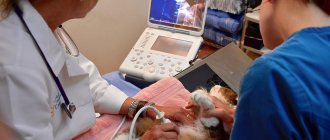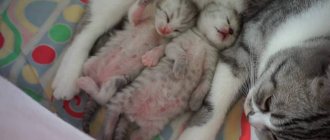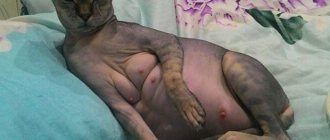The extraordinary appearance of sphinxes sometimes raises suspicions that even the simplest physiological processes in this breed are “not like everyone else.” As a result, a novice breeder has no idea how to care for a pregnant hairless cat in order to get healthy babies. Therefore, it is important to clarify in advance how long gestation lasts, how childbirth occurs in sphinxes, and how the owner of the woman in labor should behave.
How to tell if a cat is pregnant
After the planned mating has taken place, the owner needs to make sure of its effectiveness. Not every contact with animals becomes productive, and even more so with purebred Sphynx cats. But if the desired event does happen, you can find out about it by certain signs. From the first week of pregnancy, characteristic changes occur in the appearance and behavior of the animal.
Behavior change
Sphinxes are incredibly affectionate and sociable, despite their extraordinary appearance and unfriendly “facial expression”. In the first phase of pregnancy they begin to require more attention. This period does not last long, and the cat’s mood changes dramatically: the pregnant woman becomes capricious and aggressive.
Eating habits are also changing. A pregnant Sphynx refuses her usual food and develops new gastronomic preferences. Manifestations of toxicosis are possible: in the 3rd week, the cat may feel sick in the morning. We can say that a pregnant Sphynx behaves like all women in an interesting position.
All these changes are caused by a sharp hormonal change in the body: the cat will have to bear offspring and provide them with the necessary nutrients.
This period will end in 2–3 weeks. The pet's behavior will stabilize, the appetite will return and even become stronger. A pregnant Sphynx should be fed more often than usual, but the portions should be smaller. The cat's behavior will become calm and she will sleep more.
External changes
Signs of pregnancy become obvious 3 weeks after mating. They are not difficult to spot because sphinxes are hairless. The nipples become enlarged and take on a milky or pink hue. Weight gain is also a characteristic sign of pregnancy.
The physical changes in an ordinary cat are hidden under the fur, so their pregnancy often comes as a surprise to their owners.
First mating
The first mating for Canadian Sphynxes should be organized only after your pet is at least one and a half years old. At the same time, the cat will be completely ready for mating only after two, or even better, three heats. As for cats, the ideal age for the first mating is one and a half to two years, since only at this age the animal’s body has already formed. It should be noted that care should be taken to ensure that by this age both male and female cats have already received all the necessary vaccinations. Please note that under no circumstances should animals be vaccinated two weeks before mating.
How long does pregnancy last in Sphynx cats?
The average length of pregnancy for Sphynx cats is 58–68 days. Childbirth at this stage is considered physiological, and kittens are born viable and healthy. Primiparous Sphynx cats usually stay pregnant longer than multiparous ones, and they have fewer kittens.
This is interesting! The gestation period for short-haired and hairless cats is shorter (58–68 days) than for long-haired cats (62–72 days).
Features of the behavior and appearance of the sphinx depending on the stage of pregnancy.
| Gestational age | What happens in a cat's body | Appearance | Behavior |
| 1 Week | Fertilized cells begin to divide. Attachment of the embryo to the walls of the uterus occurs after the 7th day. | There are no visible changes. | The cat becomes more affectionate. |
| 2–3 weeks (8–21st day) | The formation of the placenta begins and the process is completed by the 15th day of pregnancy. | Swelling, enlargement and change in color of the nipples. | The cat is capricious, picky about food, and tries to hide in a secluded place. |
| Week 4 (22–28 days) | The embryos begin to form internal organs. | Weight gain. Belly shaping. | The likelihood of toxicosis. The appetite is returning. |
| 5–6 weeks (29–42 days) | Formation of sensory organs, nervous system, muscle and bone frame of the fetus. By the end of the 6th week, the sex of the kittens can be determined by ultrasound. | The belly becomes noticeable. The nipples and mammary glands are clearly visible. The kittens are observed moving. An experienced veterinarian can determine their number by palpation. | The cat sleeps a lot. At this time, it is very important to provide her with psychological comfort and peace of mind. |
| 7–8 weeks (43–56 days) | The skeletal system of embryos is fully formed. The development of the fetal body is completed. Kittens are ready to be born. | The Sphinx's belly reaches its maximum size. | A good appetite and plenty of sleep are a guarantee of a successful delivery. |
| Week 9 (days 56–63) | Continuing pregnancy. Kittens “mature” in the mother’s body. | The mammary glands increase in size and begin to secrete colostrum when pressed. Whitish discharge appears from the vulva. | The Sphynx cat is showing signs of restlessness and is looking for a place to build a nest for its offspring. She pays a lot of attention to the intimate toilet. Frequent urination is noted. Appetite may decrease. |
Choosing a mating partner
Shortly before breeding Canadian Sphynxes, you should definitely take the animals to the veterinarian to make sure that your cat does not have any diseases. In addition, approximately fifteen to twenty days before mating, both partners should undergo deworming for the purpose of prevention. This will allow your pet to receive a guarantee that pregnancy will not be complicated by the presence of worms.
Check your cat's readiness to bear offspring with a veterinarian
Immediately before mating, both the male and the female must trim their claws, otherwise the animals may injure their partner during the mating process. And keep in mind that you should never wash cats before breeding. This is explained by the fact that washing can destroy the real smell of the cat, which attracts the male, which, in the end, can result in a failed mating.
Features of caring for an expectant mother
A pregnant Sphynx cat should be surrounded with care and attention. It is necessary to provide adequate nutrition with a balance of vitamins and minerals. A sufficient amount of protein and calcium in the expectant mother's diet will ensure the proper development of the kittens. The best solution to the problem is to purchase special food for pregnant cats.
Ensuring the psychological and physical comfort of the pregnant woman is no less important. If the sphinx did not have her own bed, you should arrange a secluded corner for her where the birth will take place - for example, install a spacious box with low sides. A soft bedding is placed at the bottom, which is easy to change if necessary. Disposable diapers are suitable for this purpose.
From the second half of pregnancy, it is advisable to protect the sphinx from the need to make sudden movements, protect her from accidental blows and falls, and high jumps. To lift a cat, you need to grab it under the chest with one hand and under the hind legs with the other.
During pregnancy, it is strictly forbidden to carry out antiparasitic treatment - this will harm the offspring. Do not use any medications unless absolutely necessary and without consulting a veterinarian.
If the cat is kept free-range, this practice will have to be stopped during pregnancy to avoid trouble. The sphinx should be protected from contact with the opposite sex.
Important! Sometimes a cat may go into another heat cycle even when she is pregnant. This happens with a lack of progesterone. If mating occurs during estrus during pregnancy, secondary fertilization is possible. Both “batch” of kittens will be born at the same time, but those conceived later will be born non-viable.
Maintaining good hygiene is very important. Sphynx cats sweat more due to hormonal changes. In the first weeks of pregnancy, you can wash them as usual. Closer to childbirth, it is better to limit yourself to frequently wiping the body with a damp cloth. After the procedure, you need to wrap the cat in a warm towel to avoid hypothermia.
Basic rule of knitting
First of all, every owner or breeder should understand that under no circumstances should one get carried away with various drugs that are used to stop or suppress estrus in cats. This is explained by the fact that these drugs have a hormonal structure. Therefore, increased use of these medications can lead, at a minimum, to hormonal disruption in the cat’s body, and at maximum, provoke the development of serious diseases. It is for this reason that every owner should decide on the choice of a suitable pair for mating his pet, and, therefore, he will have to prepare in advance for this process in all its details.
Sphynx mom and baby
What you may need during childbirth
Under natural conditions, all animals give birth on their own, but domestic cats need help. The characteristics of the breed can cause an unfavorable course of labor, so the presence of a specialist will not be superfluous.
Before giving birth, it is necessary to prepare the following “obstetric kit” in advance:
- sterile latex gloves;
- disinfectant;
- scissors with blunt ends for opening the amniotic sac;
- pipette with a round tip - to suck out liquid from the kitten's respiratory tract;
- small pieces of clean cloth that does not leave lint;
- artificial nutrition for newborns (if the young mother does not have milk).
Weighing scales, paper and pen for recording the weight and time of birth of kittens are an important addition. This will allow you to track the physical development of the offspring “from scratch.”
Gestation course, number and development of fetuses
How does gestation proceed in cats? Regardless of how many days they carry the cubs, in the absence of any deviations, this process follows a standard scenario. Conventionally, this period can be divided into 4 stages:
- 3–4 weeks;
- 5–6 weeks;
- 7–8 weeks;
- 9–10 weeks.
| Gestation period, weeks | Changes occurring in the cat and cubs | Fruit size, cm |
| 3–4 |
| 4 |
| 5–6 |
| 6 |
| 7–8 |
| 9,5 |
| 9–10 |
| 12,5 |
During the first pregnancy, most pets give birth to 1 to 3 cubs. Mature females usually give birth to 6–8 kittens. In addition to age, how many kittens a cat can give birth to is influenced by breed, heredity, length of gestation, health characteristics, lifestyle and living conditions, as well as quality of nutrition.
We suggest you familiarize yourself with: Flea collar with celandine, difference from other flea collars
How does childbirth occur in sphinxes?
The time of birth is easy to calculate taking into account the date of the planned mating. The cat should be monitored more closely during the last week of pregnancy. You should not leave the sphinx alone for a long time; she requires the presence of her owner. Her behavior changes: she either tries to hide, then calls her owner, often lies down in her nest and leaves it.
1-3 days before the end of pregnancy, the Sphynx's temperature may drop: the tips of the ears and paws become cold. All of these are behavioral symptoms of impending labor.
Signs of imminent labor
The following signs will notify you of the onset of labor:
- the cat actively licks the belly and vulva;
- breathing rate increases;
- the cat arches its back and meows - contractions begin;
- thick red-brown or transparent mucus is released from the vulva - the plug has come out, the uterus has begun to open.
When labor begins, you need to calm the cat down. If she rushes around the house, she needs to be taken into a box and laid on her side - this is the most comfortable position. You should not allow the Sphynx to sit down - an inexperienced mother can injure or crush the kitten. The owner's voice and stroking will calm the animal.
Stages of labor
Labor takes place in several stages:
- The passage of the mucus plug indicates the beginning of the first stage of labor.
- Period of contractions. Its duration can reach 12 hours. At this time, the uterine os opens (it is bicornuate in cats). During the birth process, kittens (alternately from different horns) will enter the body of the uterus to be born. When the interval between contractions is reduced to 30–40 seconds, the next stage begins.
- Pushing period. Muscle contractions push the fetus towards the birth canal, pressure on which causes pushing. The cat pushes, expels the fetus through the birth canal.
- Stage of childbirth. The kitten is born in the amniotic sac. The Sphinx actively licks it, thereby breaking the membrane, removing amniotic fluid from the throat and stimulating respiratory activity. In the next push, the placenta comes out, which the cat eats after chewing the umbilical cord. The mother then pushes the firstborn towards the nipple. Active sucking stimulates subsequent labor.
After a short break, the entire cycle is repeated as many times as kittens were conceived. On average, the labor of a sphinx lasts from 2 to 8 hours. After several kittens are born, labor may stop. This is not a cause for alarm: labor will resume in a few hours.
Inexperienced obstetricians may be shocked that a cat eats the placenta. This process cannot be interfered with. The placenta contains hormones and biologically active substances that help during childbirth: they give strength and stimulate uterine contractions.
Felinologists advise allowing the cat to eat the first 3-4 afterbirths, and removing the rest as they appear.
False and frozen pregnancy: diagnosis and treatment
| Types of pathologies | Causes of the pathological condition | Diagnostic methods | Treatment options |
| False (imaginary) pregnancy |
|
| Low-calorie diet, therapy aimed at normalizing the production of sex hormones or sterilization. |
| Frozen pregnancy |
| If not all embryos die, the pregnancy continues. Dead fetuses are released during the birth process along with the living ones. If not a single embryo survives, a miscarriage is expected or labor is induced with medication. After birth, the cat is examined to assess the cleanliness of the uterus. Often an animal that has suffered a frozen pregnancy is sterilized. |
In what situations do you need help?
If the owner of a purebred cat is not sure that he can cope with the birth process on his own, you need to invite a veterinarian.
In force majeure circumstances, the woman in labor will have to help herself. This happens during a rapid birth: the kittens come one after another, and the mother does not have time to cope with them. An example situation: the cat has not finished licking the first one, the second kitten has already appeared, and attempts are being made on the third.
Assistant actions:
- quickly and carefully free the newborn from the membrane of the amniotic sac, slightly cutting it;
- using a sterile napkin, release the kitten from the shell;
- wipe him, at this moment he should begin to breathe;
- if the kitten is not breathing, you should turn it head down and shake it slightly;
- if this also does not help, you need to suck out the liquid from the spout using a pipette and do a light massage of the chest - rhythmically press on the heart area;
- Place the kitten close to the mother's nipple and help her latch on to it.
The cat did not have time to gnaw the umbilical cord:
- Tie the cord tightly with a clean thread at a distance of 1–2 cm from the kitten’s belly;
- cut the umbilical cord with scissors from the placenta side;
- remove the placenta.
The fetus came out partially, got stuck in the birth canal - the sphinx does not have enough strength to push. In this situation, you need to act as follows:
- lubricate the vulva around the fetus with Vaseline oil;
- Carefully grab the kitten using a napkin;
- wait for the next push, then lightly pull and help him come out;
- place the newborn next to the mother.
Normally, childbirth in sphinxes lasts from 4–5 hours to a day. The completion of labor is indicated by the behavior of the cat. She begins her own hygiene after licking the kittens.
To maintain your cat's strength, you can give her warmed milk with yolk.
Preparing for the event
Sphynx pregnancy lasts about two months - from 60 to 70 days. During this time, you should get used to the idea of expanding your family and prepare for the event. There is no need to worry about the process itself. As a rule, females cope with everything themselves. Sphynx cats have very well developed maternal instincts, so if the cat is healthy and has not had any problems during pregnancy, trust her. But there are points that you should take care of.
Location requirements
Cats are independent creatures and love to spend time alone and in silence. And during the birth process, cats generally have a special mental state, so they need peace and privacy. It would be better if it was a separate, quiet room. But you can select a secluded corner and put a special cat house in it or build it from a large cardboard box.
We recommend reading: Jaundice in cats: causes, symptoms and treatment methods
The best option is if it opens from the top, but has a small hole on the side so that the cat can get out to eat and go to the toilet. This hole should be located at such a height that small kittens cannot then accidentally crawl out of the box. You need to lay something soft inside to make it warm and comfortable. But cover it with disposable diapers (can be purchased at any pharmacy or children's store). These diapers are very soft, absorb moisture well and are easy to change.
As soon as you notice that the pet has begun to worry, look for a secluded place and drag soft things there, place it in the house and stay with it, gently talking and stroking it. This way the animal will calm down and understand that there is no need to look for a place anymore.
Materials and tools
Usually cats cope with everything themselves: they help the kitten to appear, lick it, and gnaw the umbilical cord. But you must be ready to join the process at any time and help your pet. Especially if she is giving birth for the first time.
So, you will need:
- sterile medical gloves, which can be purchased at any pharmacy;
- sterile thread, disinfectant, scissors. You will need these tools if you need to cut the umbilical cord;
- small pipette or syringe: for sucking liquid from the nasal and oral cavity;
- clean soft napkins or pieces of cloth;
- Vaseline oil;
- artificial food: it is better to purchase a special one for cats, but as a last resort, for the first time you can get by with high-quality children’s food;
- if you want to monitor whether the baby is developing correctly, then scales, paper and a pen to record the weight;
- colorful ribbons: used to mark kittens. It is very convenient when artificial feeding or when there are a lot of babies, they help make sure that everyone eats.
Stages
British cats are pregnant for just over two months. Bearing kittens is divided into several stages. For simplicity, we divide pregnancy into three stages:
- Beginning of pregnancy. The first stage lasts up to 25 days. The nipples noticeably turn pink, the belly increases slightly, becomes rounded and flexible. After 14 days, the fruits increase by about a centimeter. Limbs gradually form, internal organs begin to form. The cat eats abundantly, sleeps more often, and begins to look closely at the place where the future birth will take place.
- Mid-pregnancy. The second stage allows you to determine pregnancy with the naked eye at home. British cats are gentle and vulnerable animals; pregnancy takes a lot of strength and energy, so it would be a good idea to make an appointment with a specialist. Of course, in most cases the cat is able to give birth on her own, but a little safety net won’t hurt.
- At this stage, the brain, bone tissue (at first in the form of cartilage), muscle tissue, and the makings of the genitourinary system are actively formed. Claws are formed, the fetus vaguely resembles a kitten. The stage lasts on average 7-12 days. By the end of the trimester, kittens reach a size of 3 cm.
- End of pregnancy (preparation for childbirth). The “interesting” situation is entering its final phase. Due to the large belly (depending on the number of kittens), it is uncomfortable for the cat to walk and lick itself. Much at the third stage depends on the owner. From the attention and guessing of a silent and sometimes overly noisy British cat.
- The owner must make sure that the pet has enough food and clean fresh water, and a place for birth is equipped (even if it is a simple cardboard box). You can even turn it into a comfortable place to relax. In addition, at first, the kittens will live near the cat and begin to explore the outside world when they grow up a little. Without supervision, even a small apartment is fraught with many dangers for newborns.
By 40-45 days, kittens develop hair and an individual color. The third stage should be fully controlled either by a specialist or by family members. The cat may experience panic, depression, lethargy, and go to the toilet in the wrong place. If you touch the belly of a British cat, you can feel the movement of newborns.











